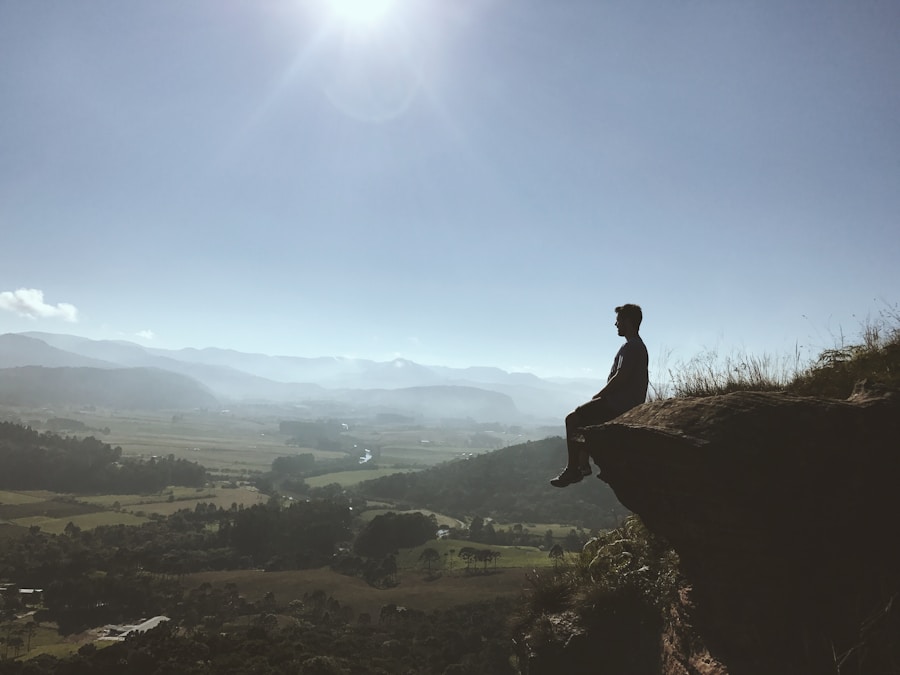Kundalini awakening is a profound spiritual experience that many seek on their journey towards self-realisation and enlightenment. At its core, Kundalini refers to a dormant energy believed to reside at the base of the spine, often depicted as a coiled serpent. When this energy is awakened, it rises through the chakras, or energy centres, along the spine, leading to heightened states of consciousness and spiritual awakening.
You may find that this process can be both exhilarating and challenging, as it often brings to the surface deep-seated emotions and unresolved issues that require your attention. As you delve deeper into the concept of Kundalini, it becomes clear that this awakening is not merely a mystical experience but a transformative journey that can lead to profound personal growth. You may experience shifts in perception, increased creativity, and a deeper connection to your inner self and the universe.
However, it is essential to approach this journey with respect and caution, as the awakening process can be intense and may require guidance from experienced practitioners. Understanding the nuances of Kundalini awakening will help you navigate this path with greater awareness and intention.
Summary
- Kundalini awakening is the process of spiritual enlightenment and self-realization through the activation of the kundalini energy at the base of the spine.
- Breathwork is crucial in Kundalini awakening as it helps to regulate the flow of energy and facilitates the movement of kundalini energy through the body.
- Techniques such as deep belly breathing, alternate nostril breathing, and breath of fire can help to awaken and balance the kundalini energy.
- The breath is closely linked to the flow of energy in the body, and conscious breathing can help to remove blockages and promote a smooth energy flow.
- Pranayama, or yogic breathing exercises, play a significant role in Kundalini awakening by purifying the energy channels and preparing the body for the awakening process.
The Importance of Breathwork in Kundalini Awakening
The Power of Conscious Breathing
This practice can help you cultivate a deeper connection with your body and mind, creating a harmonious environment for spiritual growth. Moreover, breathwork can assist in grounding you during the sometimes overwhelming experiences associated with Kundalini awakening. As you navigate the highs and lows of this journey, maintaining a steady breath can help anchor you in the present moment.
Embracing the Full Spectrum of Experience
This grounding effect is crucial, as it allows you to process the emotions and sensations that arise during your awakening. By integrating breathwork into your practice, you create a safe space for exploration and transformation, enabling you to embrace the full spectrum of your experience.
A Safe Space for Transformation
By harnessing the power of breathwork, you can navigate the complexities of Kundalini awakening with greater ease and awareness. This practice offers a profound opportunity for growth, self-discovery, and spiritual evolution.
Breathwork Techniques for Kundalini Awakening

There are various breathwork techniques that can support your Kundalini awakening journey, each offering unique benefits and experiences. One popular method is the practice of deep diaphragmatic breathing, which involves inhaling deeply through your nose, allowing your abdomen to expand fully before exhaling slowly through your mouth. This technique not only calms the mind but also helps to activate the energy centres within your body, promoting the flow of Kundalini energy.
Another effective technique is the use of rapid, rhythmic breathing known as “Kapalabhati” or “Skull Shining Breath.” This practice involves short, forceful exhales followed by passive inhales, which can energise your system and stimulate the base chakra where Kundalini resides. As you engage in this technique, you may feel a surge of energy rising within you, paving the way for deeper spiritual experiences.
The Connection Between Breath and Energy Flow
The relationship between breath and energy flow is fundamental to understanding how breathwork can enhance your Kundalini awakening experience. Your breath acts as a conduit for prana, or life force energy, which flows through your body and nourishes your chakras. When you breathe consciously, you are not only oxygenating your body but also facilitating the movement of this vital energy.
As you become more attuned to your breath, you may notice how different breathing patterns can influence your emotional state and energy levels. For instance, shallow or rapid breathing can lead to feelings of anxiety or restlessness, while slow, deep breaths can promote relaxation and clarity.
By harnessing the power of your breath, you can consciously direct energy flow within your body, helping to clear blockages and create space for Kundalini energy to rise. This awareness will empower you to take charge of your spiritual practice and enhance your overall well-being.
The Role of Pranayama in Kundalini Awakening
Pranayama, the ancient yogic practice of breath control, plays a significant role in facilitating Kundalini awakening. The term “pranayama” translates to “extension of breath” or “control of life force,” highlighting its importance in managing the flow of prana within your body. By incorporating pranayama techniques into your practice, you can enhance your ability to awaken and channel Kundalini energy effectively.
One popular pranayama technique is “Nadi Shodhana,” or alternate nostril breathing. This practice balances the left and right hemispheres of the brain while harmonising the flow of energy through the nadis, or energy channels. As you engage in Nadi Shodhana, you may find that it calms your mind and prepares you for deeper meditation or spiritual exploration.
By integrating pranayama into your Kundalini awakening practice, you create a powerful synergy that supports both physical and spiritual growth.
Breathwork Practices for Balancing Chakras

Balancing your chakras is essential for a successful Kundalini awakening experience, as blocked or imbalanced energy centres can hinder the flow of Kundalini energy. Breathwork practices specifically designed for chakra balancing can help you clear these blockages and restore harmony within your system. One effective approach is to focus on each chakra individually while employing specific breath techniques tailored to their unique qualities.
For instance, when working with the root chakra located at the base of your spine, you might engage in grounding breathwork such as “Bhramari,” or humming bee breath. This technique involves inhaling deeply and then exhaling while producing a humming sound, which resonates with the root chakra’s frequency. As you practice this technique, visualise red light filling this energy centre, promoting stability and security within yourself.
By dedicating time to balance each chakra through targeted breathwork practices, you create an optimal environment for Kundalini energy to rise freely.
Breathwork for Cultivating Awareness and Mindfulness
Cultivating awareness and mindfulness is an integral aspect of any spiritual practice, including Kundalini awakening. Breathwork serves as an excellent tool for developing these qualities, allowing you to connect more deeply with yourself and the present moment. As you engage in conscious breathing exercises, you may find that distractions fade away, leaving space for introspection and self-discovery.
One effective method for fostering mindfulness through breathwork is “Box Breathing,” which involves inhaling for a count of four, holding for four counts, exhaling for four counts, and holding again for four counts before repeating the cycle. This structured approach not only calms the mind but also encourages focus on each phase of the breath cycle. As you practise box breathing regularly, you’ll likely notice an increase in your ability to remain present during meditation or daily activities, enhancing your overall experience of Kundalini awakening.
Integrating Breathwork into a Kundalini Awakening Practice
Integrating breathwork into your Kundalini awakening practice can significantly enhance your spiritual journey. To begin this integration process, consider establishing a dedicated time each day for breathwork exercises alongside other practices such as meditation or yoga. Creating a routine will help reinforce the connection between breath and energy flow while providing consistency in your spiritual development.
As you progress on this path, remain open to exploring various breathwork techniques that resonate with you personally. You might find that certain practices work better at different stages of your journey or during specific emotional states. By remaining flexible and attentive to your needs, you’ll cultivate a more profound understanding of how breathwork can support your unique experience of Kundalini awakening.
Ultimately, this integration will empower you to embrace the full spectrum of your spiritual journey while fostering a deeper connection with yourself and the universe around you.
FAQs
What is Kundalini awakening?
Kundalini awakening is a spiritual concept in which an individual experiences a profound shift in consciousness, often described as the awakening of an energy at the base of the spine. This awakening is believed to lead to spiritual enlightenment and self-realization.
What is breathwork?
Breathwork refers to various techniques that involve conscious control and manipulation of breathing patterns. These techniques are often used for relaxation, stress reduction, and spiritual development.
How does breathwork relate to Kundalini awakening?
Breathwork is believed to play a significant role in Kundalini awakening by helping to activate and channel the Kundalini energy. Certain breathing techniques are thought to stimulate the flow of energy through the body’s energy centers, known as chakras, and facilitate the awakening process.
What are some breathwork techniques used for Kundalini awakening?
Some common breathwork techniques used for Kundalini awakening include pranayama, breath of fire, alternate nostril breathing, and deep diaphragmatic breathing. These techniques are often practiced in conjunction with meditation and yoga.
Are there any risks associated with breathwork for Kundalini awakening?
While breathwork can have many benefits, it is important to approach these techniques with caution, especially when working with the powerful energy associated with Kundalini awakening. Some individuals may experience intense physical, emotional, or psychological effects, and it is advisable to seek guidance from experienced practitioners.
Can anyone practice breathwork for Kundalini awakening?
Breathwork techniques can be practiced by anyone, but it is important to approach Kundalini awakening with respect and understanding of its potential impact on the individual’s physical, mental, and spiritual well-being. It is advisable to learn these techniques from qualified instructors and to practice them mindfully.




















